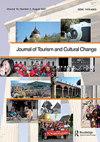与作家、音乐家和视觉艺术家有关的地方的世俗朝圣
IF 2.5
4区 管理学
Q2 HOSPITALITY, LEISURE, SPORT & TOURISM
引用次数: 0
摘要
在29个非正式访谈和91份在线问卷中,我们询问了人们对世俗朝圣的看法,这些朝圣大多与作家、音乐家和视觉艺术家有关。朝圣者在目的地通常会有强烈的情绪:在非正式研究和在线研究中,他们对自己的感动程度的平均评分为6.56分和6.14分,满分为10分。在这项在线研究中,26人参观了作家的住所,47人参观了音乐家的住所,18人参观了其他类型的艺术家的住所。我们将这些人与没有朝圣的人进行比较。在过去的五年里,较高的生活压力预示着人们在这段时间里是否会进行艺术朝圣。然而,朝圣与整体幸福感、幻想和观点采纳之间没有联系。一些阅读更多的参与者对他们访问与作家有关的地方感到失望。艺术朝圣的动机包括更新和文化变革、治疗、好奇心、敬意、有意义的体验和参观地点的提升。艺术朝圣者带着一段内心的想象,以便在他们对所参观的地方的外部感知中变得更加完整。目的地的强烈情感表明艺术家对朝圣者的重要性。本文章由计算机程序翻译,如有差异,请以英文原文为准。
Secular pilgrimage to places associated with writers, musicians, and visual artists
ABSTRACT In 29 informal interviews and 91 online questionnaires, we asked people about secular pilgrimages mostly to places associated with writers, musicians, and visual artists. Pilgrims often felt strong emotions at their destinations: mean ratings of how moved they felt on 0-to-10 scales in the informal and online studies were 6.56 and 6.14, respectively. In the online study 26 people made visits to writers’ locations, 47 to musicians’ locations, and 18 to locations of artists of other kinds. We compared these with people who had not made pilgrimages. Higher life stress experienced during the previous five years predicted whether people went on artistic pilgrimages during that time. There was, however, no association between making a pilgrimage with overall well-being, or with fantasy and perspective taking. Some participants who did more reading were disappointed by their visits to places associated with writers. Motives of art pilgrimage include renewal and cultural change, therapy, curiosity, homage, meaningful experience, and enhancement of visited places. Art pilgrims take with them a piece of inner imagination so that it can become more complete in their outer perception of the place they visit. An intense emotion at a destination indicates the importance of the artist to the pilgrim.
求助全文
通过发布文献求助,成功后即可免费获取论文全文。
去求助
来源期刊

Journal of Tourism and Cultural Change
HOSPITALITY, LEISURE, SPORT & TOURISM-
CiteScore
5.10
自引率
9.10%
发文量
31
期刊介绍:
Journal of Tourism and Cultural Change ( JTCC ) is a peer-reviewed, transdisciplinary and transnational journal. It focuses on critically examining the relationships, tensions, representations, conflicts and possibilities that exist between tourism/travel and culture/cultures in an increasingly complex global context. JTCC provides a forum for debate against the backdrop of local, regional, national and transnational understandings of identity and difference. Economic restructuring, recognitions of the cultural dimension of biodiversity and sustainable development, contests regarding the positive and negative impact of patterns of tourist behaviour on cultural diversity, and transcultural strivings - all provide an important focus for JTCC . Global capitalism, in its myriad forms engages with multiple ''ways of being'', generating new relationships, re-evaluating existing, and challenging ways of knowing and being. Tourists and the tourism industry continue to find inventive ways to commodify, transform, present/re-present and consume material culture. JTCC seeks to widen and deepen understandings of such changing relationships and stimulate critical debate by: -Adopting a multidisciplinary approach -Encouraging deep and critical approaches to policy and practice -Embracing an inclusive definition of culture -Focusing on the concept, processes and meanings of change -Encouraging trans-national/transcultural perspectives
 求助内容:
求助内容: 应助结果提醒方式:
应助结果提醒方式:


